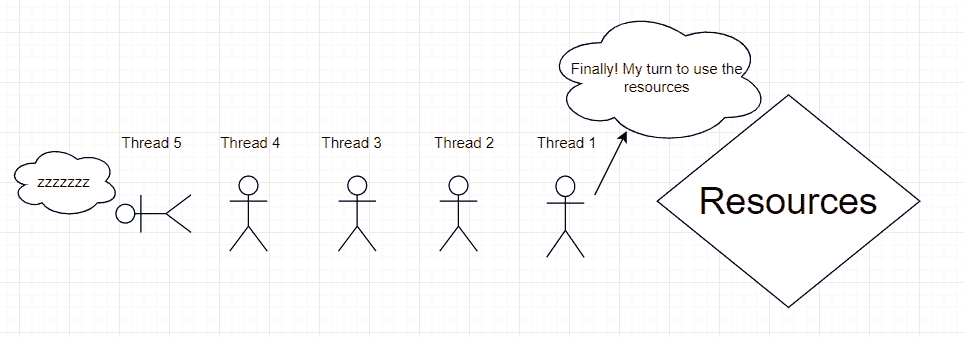在更深入地了解互斥量之前,先给出一个示例:
想想一个队列。 不管长短,都没关系。 现在想想一辆正在出售游乐园门票的卡车。 一次一个人可以买票。 该人买了票后,就该排队了。
这个小故事与理解互斥量有什么关系? 让我解释。

互斥量允许每个线程具有 1 个许可。换句话说,一次只能有 1 个线程可以访问资源。 在上面的类比中,两个人不能同时购买门票。互斥量也是如此。 它不是线程,而是人员,而是票证。 同样的事情或多或少..
互斥量与Semaphore略有不同,因此Semaphore允许多个线程访问资源。意思是,多个人可以同时购买门票。

构造器
public Semaphore(int permits);public Semaphore(int permits, boolean fair)
第一个构造函数是我们实际上可以区分互斥量和Semaphore的地方。 如果那里有 1 作为参数,则意味着将只允许 1 个线程获取锁。 请记住,由于它没有第二个参数boolean fair,因此您正在使Semaphore类以任何顺序访问任何线程。
第二个构造函数如果传递true(公平),则确保按线程请求访问并在队列中等待的顺序给出访问。
互斥量基本代码实现
import java.util.concurrent.Semaphore;public class MutexDemo {// create a Semaphore instance that makes it so only 1 thread can access resource at a timeprivate static Semaphore mutex = new Semaphore(1);static class ThreadDemo extends Thread {private String name = "";public ThreadDemo(String name) {this.name = name;}@Overridepublic void run() {try {// check the above mentioned analogy in the article for referenceSystem.out.println("How many people can buy a ticket at a time: " + mutex.availablePermits());System.out.println(name + " is buying a ticket...");mutex.acquire();try {Thread.sleep(1000);System.out.println(name + " is still buying a ticket. How many people can still buy the ticket alongside him: " + mutex.availablePermits());} finally {mutex.release();System.out.println(name + " bought the ticket.");System.out.println("How many people can buy tickets after " + name + " has finished buying the ticket: " + mutex.availablePermits());}} catch (Exception e) {e.printStackTrace();}}}public static void main(String[] args) {ThreadDemo thread1 = new ThreadDemo("Bob");thread1.start();ThreadDemo thread2 = new ThreadDemo("Charlie");thread2.start();ThreadDemo thread3 = new ThreadDemo("Christie");thread3.start();}}
输出
How many people can buy a ticket at a time: 1Bob is buying a ticket...How many people can buy a ticket at a time: 0Charlie is buying a ticket...How many people can buy a ticket at a time: 0Christie is buying a ticket...Bob is still buying a ticket. How many people can still buy the ticket alongside him: 0Bob bought the ticket.How many people can buy tickets after Bob has finished buying the ticket: 1Charlie is still buying a ticket. How many people can still buy the ticket alongside him: 0Charlie bought the ticket.How many people can buy tickets after Charlie has finished buying the ticket: 1Christie is still buying a ticket. How many people can still buy the ticket alongside him: 0Christie bought the ticket.How many people can buy tickets after Christie has finished buying the ticket: 1
从输出中可以看到,当有人买票时,没有其他人可以买。这是显示以下内容的行之一:
Bob 仍在买票。 还有多少人可以和他一起买票: 0
但是,在他“购买”了机票之后,其他人立即购买了机票。
归根结底,它涉及acquire()和release()。acquire()是指该人开始“购买机票”的时间,release()是指该人“购买机票”的时间。

